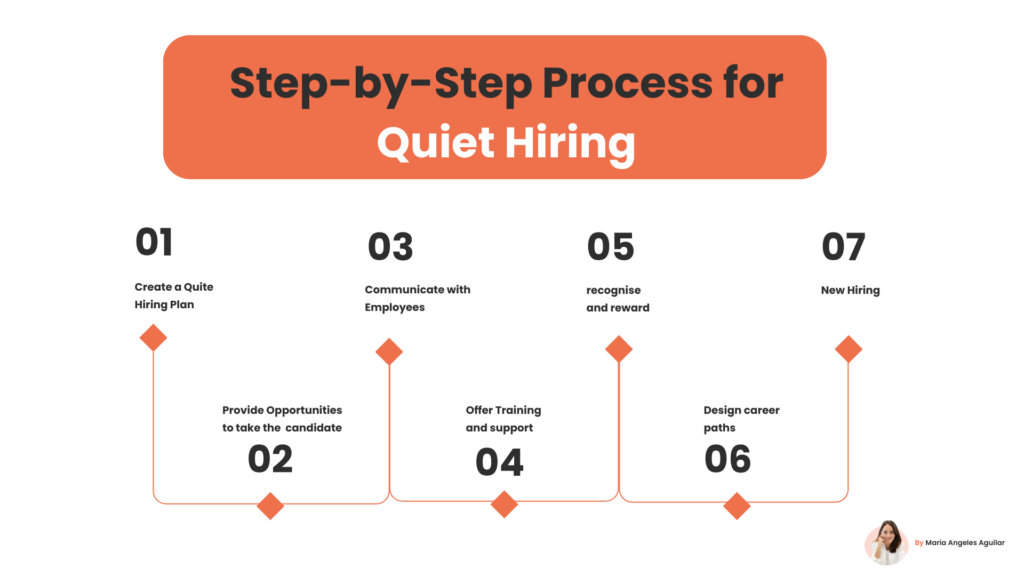The hiring process is essential for any company or organisation. Applicants have a significant impact on companies’ success and competitiveness. Although the hiring process is traditionally a noisy process, full of job advertisements, interviews, tests and evaluations, a new trend has emerged that is changing the way companies search for talent: quiet hiring.
HR experts have been talking about a number of new terms in the workplace, such as “quiet quitting” and “silent firing.” However, one phenomenon in particular, known as silent hiring, is growing and is predicted to be a key strategy for companies in the upcoming years.

In an ever-changing world of work, silent recruiting is quickly becoming a transformative approach to talent acquisition. It is characterised by careful introspection, mindfulness and a more complete evaluation of candidates, which leads to quietly building high-performing teams.
In this article, we’ll delve into the concept of silent recruiting, its art, and how it can help organisations attract and retain talent in an ever-evolving world of work. Additionally, we will explain how this trend will shape the workplace in the near future.
Table of Contents
What is quiet hiring?
Quiet hiring, also known as silent hiring, is a hiring approach that differs significantly from traditional methods in several fundamental aspects. While the conventional hiring process often involves the public posting of vacancies and the resulting influx of applicants, companies that embrace quiet hiring take a discreet and highly selective approach.
Instead of making noise in the labour market, these organisations are dedicated to searching for candidates strategically, often through the company’s more private and select channels. This approach is based on the premise that quality trumps quantity and that by carefully selecting the right candidates, it is possible to build highly effective teams.
Companies often look to hire charismatic and outgoing people. However, silent hiring suggests that it is essential to evaluate qualities that are not always evident to the naked eye. This approach values skills such as emotional intelligence, adaptability and team collaboration. Observing essential skills, such as empathy, resilience and the ability to listen carefully, are key aspects that are not considered in traditional selection processes. Silent hiring places new value on candidates who excel in these skills, recognising that their contributions can have a profound impact on team dynamics, innovation, and the overall culture of the organisation.
This approach represents a response to the need to build high-performing teams more efficiently and discreetly, minimising disruptions to the work environment and focusing on the quality of candidates, beyond their initial visibility.
Significant differences between quiet quitting and quiet hiring
This emerging trend in human resources arises in response to another growing phenomenon known as quiet quitting. Quiet hiring and quiet quitting are two different concepts that refer to different aspects of the employment process and are not directly related to each other. For a better understanding of the term studied in this article, we must appeal to the differentiation between both concepts:
Quiet hiring
Quiet hiring refers to a strategic hiring approach in which companies actively search for high-quality talent without necessarily publicly announcing vacancies. This approach is based on the premise that the quality of candidates trumps quantity, and focuses on identifying and selecting candidates who possess specific skills and fit well with the company culture. The goal is to build high-performing teams efficiently while minimising disruptions to the existing work environment.
Quiet quitting
Quiet quitting refers to a phenomenon in which employees decide to leave their jobs without directly notifying their employer. Instead of submitting a formal resignation, these employees can simply stop coming to work or gradually reduce their work commitment. This behaviour can be due to a variety of reasons, such as dissatisfaction with work, communication problems, or changes in personal circumstances.

Quiet hiring methodically selects high-quality candidates based on skills and cultural fit.
The importance of quiet hiring for HR management
The primary objective of the practice of quiet hiring is to encourage the development of skills and capabilities in employees so that they can assume multiple responsibilities and functions, allowing companies to avoid the need to hire new workers and assist in the development of the internal team.
To increase work productivity and reduce costs, companies tend to assign greater tasks to their current employees. This not only expands the skills and competencies of employees but also allows them to diversify their tasks and responsibilities.
The practice of “Quiet Hiring” presents a series of benefits that can improve both companies and candidates. Key benefits include:
Higher quality of candidates
Less is more. By avoiding making too much noise about job openings, companies can attract candidates who truly want to be part of their culture and philosophy. With this, they achieve a higher quality of candidates, since those who are not truly committed will rarely bother to look for opportunities through silent channels.
Greater commitment to internal talent
Catch and retain the best. Candidates who are selected through quiet hiring are generally more aligned with the company’s values and objectives, which increases the likelihood that they will stay long-term. This saves time and resources that would otherwise be spent on staff turnover.
Greater savings in hiring costs
Saving is the key. The traditional hiring process can be costly in terms of resources, from advertising jobs to managing numerous applicants. Quiet hiring reduces these costs by focusing on a limited number of highly qualified candidates.
Challenges of quiet hiring
Although the discreet recruitment method has its advantages as seen above, the challenges related cannot be ignored. Some of the common obstacles include:
Lack of diversity
Silent hiring can reduce diversity in the selection process since personal connections tend to be homogeneous. It is important to be aware of this issue and take steps to ensure inclusion and diversity in the workplace.
Fewer available candidates
Silent hiring may take longer to identify suitable candidates since there is not a constant influx of applicants. This can delay hiring, especially in high-demand situations.
Lack of transparency
By keeping the hiring process low-key, there may be a lack of transparency that causes concerns among current employees and potential applicants. Communicating effectively is essential to addressing this challenge.
Impact on worker mental health
Silent hiring does not replace tasks, but adds them, which can generate work overload that affects the worker’s mental health, with the appearance of symptoms of stress or burnout.
Reduction of commitment
If the new tasks assigned to employees are not attractive, do not motivate them or do not complement their usual functions, the worker will likely lose the desire to continue collaborating in the company due to a lack of commitment.
Quiet hiring strategies
The art of quiet hiring requires a well-planned strategy. Just as this trend has multiple benefits, if a good strategy is not established it can lead to various impediments. Here we’ll outline some keys to carrying out an effective silent hiring process:
- Personal and professional contacts
Most quiet hiring opportunities originate from personal and professional connections as well as internally in the company. Maintaining and expanding a strong network is essential to accessing high-quality candidates.
- Active search
Instead of waiting for candidates to come forward, companies should proactively search for people with skills and experiences that fit their needs. This involves exploring profiles on professional social networks, attending relevant conferences and events, and staying informed about the job market.
- Employer brand
In line with the previous strategy, working on the employer brand of both the company and the professionals of the HR team is vital to creating a good network of contacts so that when the time comes to make silent hiring, you have a good foundation of data.
- Internal employee referrals
Current employees can be a valuable source of potential candidates. Implementing internal referral programs can incentivise employees to recommend quality candidates.
- Work with specialised agencies
Collaborating with recruiting agencies specialised in the industry or specific roles can help access highly qualified candidates who might otherwise go unnoticed.
- Rigorous evaluation
Silent hiring does not mean skipping rigorous evaluation processes. In fact, it is crucial to evaluate candidates thoroughly to ensure they are a good match for the company.

Quiet hiring develops employee skills for multifunctional roles, reducing new hires and improving productivity.
Ethical and strategic considerations
If your organisation is considering applying the quiet hiring trend via internal promotions, you must take into account the work overload that it may entail for the collaborators themselves. Below are the following points that should be taken into account to avoid negative impacts in the practice of this trend:
- List of objectives: It is essential to have a list of work objectives for the team in question. This way, leaders and employees will be able to clearly see the tasks they have been assigned, allowing delegated workloads to be compared.
- Measurable progress: Measuring the progress of each objective using parameters (percentages, metrics, etc.) is important to know the specific progress of each task and to know which ones need support to move forward.
- Evidence: Uploading files to the performance evaluation platform helps document each step of the process. If a goal is delegated halfway through, the employee can pick up where they left off.
- Group evaluations: It is useful for leaders to have all the evaluated workers on the same screen. In this way, they can score employees’ competencies and/or values to monitor their progress in performance.
- Performance evaluations: Performance evaluations are fundamental in this trend. They allow you to identify workers who are adapting correctly to their new roles and those who need help before it is too late.
Considering the benefits of silent hiring within your organisation, it is essential to keep track of the capabilities and growth of your talent. Doing so is vital to assigning new responsibilities.
Examples of successful use cases
Below we discuss the effectiveness of quiet hiring with some examples of well-known companies that have found success with this approach.
Despite being one of the most famous companies in the world, Google has used quiet hiring to attract exceptional talent. The company uses internal connections and referrals to locate highly qualified candidates who fit its culture and values.
SpaceX
Elon Musk’s aerospace company prefers to keep a low profile when hiring highly specialised talent for critical projects. Silent hiring has allowed SpaceX to build a team of top engineers and scientists in their field.
Apple
Apple is known for its discretion in the hiring process, especially when it comes to key roles like product design. The company seeks creativity and experience through internal networks and previously established connections.
The art of quiet hiring is changing the way companies build their teams. By focusing on quality over quantity and maintaining a discrete and strategic hiring process, organisations can improve the quality of their employees and strengthen their corporate culture. While quiet hiring isn’t right for every situation, it can be a powerful strategy for those looking for high-performing teams in silence.
Future of quiet hiring
The future of quiet hiring is full of exciting opportunities and challenges as organisations adapt to an ever-changing work environment. As it evolves, it is important to consider emerging trends, the role of artificial intelligence (AI) and the necessary adaptation to a constantly changing world of work as well as the incorporation of new generations into work environments.
Emerging trends in quiet hiring
Quiet hiring does not sit idly by and constantly evolves to adapt to the changing needs of the labour market. Some trends in this hiring approach include:
- Greater emphasis on diversity and inclusion: As diversity in the workplace becomes more important, quiet hiring is adapting to ensure candidates from diverse perspectives and backgrounds are considered. Companies are incorporating more inclusive and diversified practices into their quiet hiring strategies.
- Greater use of data analytics: Data collection and analysis are critical in making informed decisions in the silent hiring process. Companies are using data analytics to identify trends and profiles of successful candidates, allowing them to refine their quiet hiring strategies.
- Increasing integration of professional social networks: Professional social networks, such as LinkedIn, are increasingly present in the search and evaluation of candidates at quiet hiring. Companies are leveraging these platforms to identify and connect with high-quality professionals discreetly.
The role of artificial intelligence and automation
AI and automation play a prominent role in the future of talent acquisition. These technologies allow companies to identify, evaluate and select candidates more efficiently. Some ways AI and automation are transforming talent acquisition include:
- Resume filtering and sorting: AI systems can analyse resumes and online profiles to rank candidates based on their skills and experiences, saving time in the initial screening phase.
- AI-assisted virtual interviews: AI-assisted virtual interviews can evaluate candidates’ skills and competencies more objectively, eliminating human bias in the process.
- Cultural fit prediction: AI can analyse data about a company’s culture and candidate profiles to predict cultural fit, making it easier to select candidates who best fit the company’s culture.
Adaptation to a constantly changing work environment
The work environment is constantly changing due to factors such as globalisation, technology, seismic events like the pandemic, and evolving employee expectations. In this context, silent hiring must adapt to remain effective. Some key areas of adaptation include:
- Remote work and flexibility: The pandemic has accelerated the adoption of remote work. Silent hiring must adapt to this new reality, considering candidates who can work effectively in remote environments.
- Digital and IT skills: Digital and IT skills are increasingly critical. Silent hiring should prioritise identifying candidates with strong digital competencies.
- Continuous assessment of candidate fit: Given the pace of change in the workforce, companies must conduct continuous assessments of candidate fit to ensure they remain a good match as organisational needs evolve.
In conclusion, “quiet hiring” is a dynamic and successful strategy that adapts to current transformations, takes advantage of artificial intelligence and automation, and adapts to a constantly evolving work environment. Companies that adopt these trends and maintain their agile approach in silent hiring will be in an advantageous position to build high-calibre teams in the future.
In short, there is no magic recipe to ensure that the quiet hiring trend is a resounding success or a total failure. Every company is unique, with employees, tasks, responsibilities and company cultures that require specific needs.
If your company decides not to hire new talent and joins this trend, we suggest that you communicate this transparently and honestly, rather than in secret. Open communication is always the best option. The proper implementation of this strategy will benefit everyone, improving the quality of work and the well-being of employees, allowing them to develop tasks that help them meet their job expectations or get closer to the positions they are looking for in the company.
Maria Angeles is a specialized psychologist and Top HR Influencer Spain dedicated to aligning individuals with their talents. Her mission revolves around establishing the Human Resources department as a strategic business unit. She transforms it into a fully digital team, implementing practices and initiatives that place the individual at the heart of the company. Maria's initiatives are founded on trust, transparency, autonomy, and self-awareness. Beyond this, she guides professionals in discovering their career purposes, empowering them to thrive in their professional journeys.




No comments yet
There are no comments on this post yet.